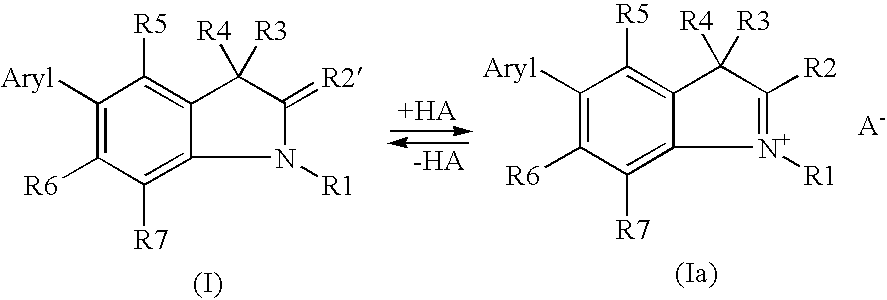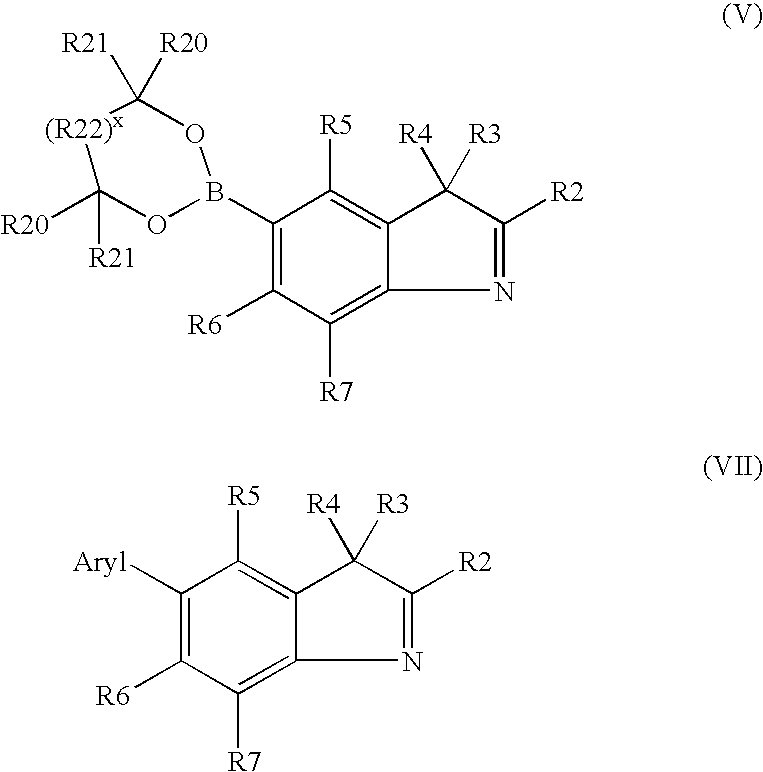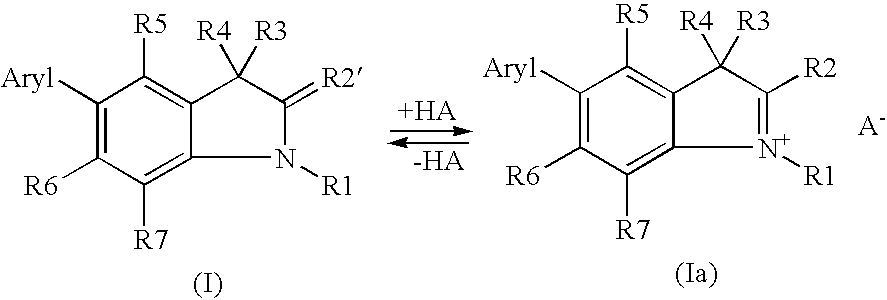5-aryl-1,3,3-trimethyl-2-methylene-indoline derivatives and salts thereof, methods for the production and use of said compounds for the temporary coloration of fibers
a technology of trimethyl-2-methyleneindoline and derivatives, which is applied in the direction of dyeing process, group 3/13 element organic compounds, hair cosmetics, etc., can solve the problems of unsuitable parallel synthesis of structurally related 5-aryl-1 and rather expensive latex, and achieves easy synthesis, good yield, and low cost
- Summary
- Abstract
- Description
- Claims
- Application Information
AI Technical Summary
Benefits of technology
Problems solved by technology
Method used
Image
Examples
examples 1.1 to 1.22
Synthesis of Indoline Derivatives of Formula (I) / (Ia)
A) General Procedure for Synthesizing 3H-indole Derivatives of Formula (VII)
Variation 1:
[0064]5-Halogeno-2,3,3-trimethyl-3H-indole (1 mole) of Formula (II) and 1.3 moles of aryl boric acid of Formula (III) are dissolved in 1,2-dimethoxyethane. Argon is bubbled through this solution for 15 minutes. Subsequently, the palladium catalyst (0.1 to 0.12 moles) and 2 to 2.6 moles of potassium carbonate dissolved in water are added. The reaction mixture is refluxed for 2 to 6 hours in an argon atmosphere. At the end of the reaction, the reaction mixture is filtered through silica gel and taken up in dichloromethane and the resulting organic phase is washed twice with 1M sodium hydroxide solution and 3 times with water, dried over magnesium sulfate and subsequently evaporated under reduced pressure at 40° C. The residue is distilled under a high vacuum or purified chromatographically.
Variation 2:
[0065]5-Dioxoborinane-2,3,3-trimethyl-3H-indo...
example 1.1
5-(2,4-Dimethoxyphenyl)-1,2,3,3-tetramethyl-3H-indole-1-ium-tetrafluoroborate
[0071]The synthesis is carried out according to variation 1 of the general synthesis procedure A), 0.92 g of 5-bromo-2,3,3-trimethyl-3H-indole and 1.01 g of 2,4-dimethoxyphenylboric acid in 20 mL of 1,2 dimethoxyethane and 0.51 g of tetrakis(triphenylphosphine)palladium(0) and 1.38 g of potassium carbonate in 5 g of water being used.
[0072]The resulting residue is purified by chromatography (silica gel, hexane / ethyl acetate 4 / 6), 0.86 g (76% of the theoretical yield) of 5-(2,4-dimethoxyphenyl)-2,3,3-trimethyl-3H-indole being obtained.
[0073]The 5-(2,4-dimethoxyphenyl)-2,3,3-trimethyl-3H-indole (0.82 g), so obtained, is alkylated, as described in variation 1 of the general procedure C), with 0.49 g of trimethyloxonium tetrafluoroborate in 5 mL of 1,2-dichloroethane. The crude product is recrystallized from methanol.
[0074]Yield: 0.61 g (55% of the theoretical) 5-(2,4-dimethoxyphenyl)-1,2,3,3-tetramethyl-3H-indo...
example 1.2
5-(1,3-Benzodioxol-5-yl)-1,2,3,3-Tetramethyl-3H-indol-1-ium tetrafluoroborate
[0080]The synthesis proceeds according to variation 1 of the general synthesis procedure A), 0.92 g of 5-bromo-2,3,3-trimethyl-3H-indole and 0.83 g of 3,4-methylenedioxyphenylboric acid in 20 mL of 1,2 dimethoxyethane and 0.51 g of tetrakis(triphenylphosphine)palladium(0) and 1.38 g of potassium carbonate in 5 g of water being used.
[0081]The resulting residue is purified by chromatography (silica gel, hexane / ethyl acetate 4 / 6), 0.89 g (83% of the theoretical yield) of 5-(1,3-benzodioxol-5-yl)-2,3,3-trimethyl-3H-indole being obtained.
[0082]The 5-(1,3-benzodioxol-5-yl)-2,3,3-trimethyl-3H-indole (0.70 g), so obtained, is alkylated, as described in variation 1 of the general procedure C), with 0.44 g of trimethyloxonium tetrafluoroborate in 4 mL of 1,2-dichloroethane. The crude product is recrystallized from 1:1 ethyl acetate / acetonitrile.
[0083]Yield: 0.65 g (68% of the theoretical) 5-(1,3-benzodioxol-5-yl)-1,2...
PUM
| Property | Measurement | Unit |
|---|---|---|
| pH | aaaaa | aaaaa |
| temperature | aaaaa | aaaaa |
| temperature | aaaaa | aaaaa |
Abstract
Description
Claims
Application Information
 Login to View More
Login to View More - R&D
- Intellectual Property
- Life Sciences
- Materials
- Tech Scout
- Unparalleled Data Quality
- Higher Quality Content
- 60% Fewer Hallucinations
Browse by: Latest US Patents, China's latest patents, Technical Efficacy Thesaurus, Application Domain, Technology Topic, Popular Technical Reports.
© 2025 PatSnap. All rights reserved.Legal|Privacy policy|Modern Slavery Act Transparency Statement|Sitemap|About US| Contact US: help@patsnap.com



